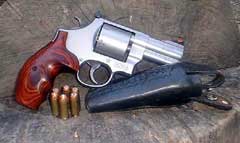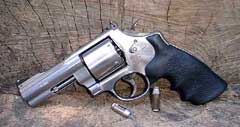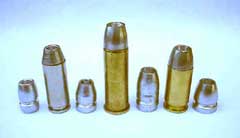|
With all the interest generated by the
two recent articles on the 10mm cartridge (The
10mm by R.K. Campbell
& Smith & Wesson Brings Back the 10mm Model 610 Revolver
by Jeff Quinn), when Glen offered to send up
this one on his classic three inch Smith & Wesson Model
610, I jumped at the chance to publish it on Gunblast.com. Glen
is a true expert on bullets, casting, handgunning, and other
such activities. I hope that you enjoy his information as much
as I did.
Jeff Quinn
  
Back in the late 1950s and
early 1960s Elmer Keith and Bill Jordan were
petitioning the American arms community to produce guns and
ammunition for a service revolver, roughly .40 or .41 caliber,
which was capable of shooting a 180-200 grain bullet at about
1100 fps. Something
that offered more thump than the pedestrian .38 Special, and
gave better penetration than did the .357 Magnum.
The .44 Magnum had just made its bawdy appearance, and
the factories had given Mr. Keith even more than he had asked
for. The resulting
240 grain bullet at almost 1500 fps generated unprecedented
recoil, so recovery was slow and follow-up shots were difficult
for most law enforcement officers.
Keith and Jordan were asking for moderation -- sufficient
bullet weight, diameter and velocity to be effective for law
enforcement applications, but not so much power that recoil made
mastery of the weapon difficult.
One might ask, “What about
the .38-40?”
Well, that’s pretty much
what Keith and Jordan were looking to emulate, except without
the thin, bottle-necked, balloon-head brass and sloppy chamber
tolerances of the older guns.
(Keep in mind that this was the early 1960s and the
.38-40 was pretty much dead in the water, it wasn‘t revived
until Cowboy Action Shooting
came along 3 decades later).
What they wanted was a new cartridge that embodied a
straight, solid-head case, holding a .40 caliber bullet, that
operated at moderate pressure and launched a 180-200 grain
bullet at 1100 fps. What
they got was the .41 Magnum, with a 210 grain bullet at 1400+
fps. Once again,
the factories delivered far more than was asked for.
The .41 Magnum went on to prove itself a fine hunting
cartridge, but recoil recovery continued to be a problem for law
enforcement applications. A
mid-range load for the .41 Magnum was offered in an attempt to
address this need, but it failed to catch on.
Double-action revolvers are
best served by straight-cased, rimmed cartridges.
Single-action revolvers can handle rimless cartridges
with ease, but double-action revolvers are generally favored
over single action revolvers by law enforcement and military as
a result of their faster reload times and the option of shooting
double-action. During
the first World War, we had large quantities of .45 ACP ammo,
but the factories were at capacity in terms of 1911 production,
and capacity was not keeping up with wartime demand.
The solution was to modify the large frame S&W and Colt
double-action revolvers to accept the .45 ACP round using
half-moon (3-round) and full-moon (6-round) clips. Thus was born the Model 1917, a birth of immediacy and need.
OK, now let’s fast-forward
to the 1980s -- a variety of new shooting games emerged during
the last quarter of the 20th century, one of which
was bowling pin shooting. Large
caliber revolvers were favored since bullet momentum was
critical to sweep the eccentrically balanced bowling pin off the
table. Competitors found that the Model 1917 provided adequate power
with modest enough recoil that shooters were able to shoot fast
and hit the pins hard, and the 1917 had the advantage that it
came with its own built in speed-loader!
The fit and popularity of the gun to the game were so
good that S&W released several special editions of the Model
625 in the late 1980s, aimed specifically at this form of
competition.
Also during this timeframe,
Jeff
Cooper was championing the 10mm cartridge and the
ill-fated Bren-Ten with which to shoot it.
In a sense, Cooper was trying to fill the same void that
Keith and Jordan had called to the world’s attention two
decades earlier, it’s just that Cooper, a devout advocate of
the Colt 1911, wasn’t promoting a service revolver, he wanted
to house this new cartridge in a semi-auto.
Those who shot the gun sung the praises of both the
cartridge and the gun, but there were problems with production
and the Bren-Ten died an ignoble death.
S&W was in a randy sort of
mindset during this period, and they were introducing new models
left and right. With
the popularity of bowling pin shooting, and all the hype
surrounding the Bren-Ten and the 10mm, why not take the concepts
introduced with the Model 1917 and apply them to the new 10mm
cartridge? Their
N-frame was certainly up to the task, and if they put a
full-lugged barrel on the new revolver (which had just proven to
be fantastically popular on their .44 Magnum Classic Hunter)
they could tame recoil and make the gun that much more
attractive to bowling pin competitors.
So in 1990 S&W introduced the Model 610 with a
production run of 5000 with either a 5” or 6 1/2” barrel.
S&W was afforded a subtle, but very real, luxury with
the 10mm -- this
was a brand new cartridge, that had no old weak guns with sloppy
tolerances that it might get loaded into, and they had a clean
slate to start with in terms of design tolerances.
The design engineers and production personnel at S&W
did not disappoint; chamber dimensions were snug and throat
diameter was half a thousandth over nominal bullet diameter, and
groove diameter matched bullet diameter quite nicely.
Upon its release, the Model 610 was universally reported
as being among the most accurate revolvers that S&W had ever
produced, and that is a bold statement indeed!
That being said, the revolver was received with a
collective yawn, and sales figures lagged. It was quietly dropped from the catalog a year later.
Things were looking shaky for
the 10mm cartridge with the Bren-Ten effort faltering, the early
Delta Elites from Colt being reported to suffer from stress
cracking in the slide, and the S&W 610 being dropped from
production. In
addition, the FBI’s experience with the 9mm in the Dade County
shoot-out led them to re-evaluate their use of the 9mm and
decide to shift gears to a larger caliber, but they decided that
the 10mm kicked too much for rapid recoil recovery, so they
wanted it loaded down. They
knew from past experience with the .45 ACP that recoil recovery
was not a problem with 185 grain bullets at about 950 fps, so
that’s what they aimed for, and amazingly that’s exactly
what S&W delivered with their brand spankin’ new .40
S&W (if they knew a .45 with a 185 wasn’t a problem, why
didn’t they just go with a .45 loaded with 185s?).
The 10mm was losing ground.
One of the other fashion
trends of the 1980s was that of the "Wonder-Nines", in
which competing firms tried to vie for the consumers’ dollars
by seeing who could cram the most 9mm cartridges into a double
stack magazine. One
of the clear innovators on this front was a previously little
known (here in America anyway) Austrian company, who pioneered
the use of polymer
grip frames. The Glock
Model 17 held 17 rounds of 9mm Parabellum ammo and had several
safety innovations, including a unique trigger mechanism
designed to prevent accidental discharges.
The Glock was immediately controversial because of its
plastic grip frame, and to this day shooters either love its
blocky profile or loathe it, there seems to be little middle
ground when it comes to the Glock.
While the 9mm was an obvious
choice for NATO applications, Americans typically want more
power, and the 10mm was specifically designed to provide optimum
power for semi-autos. Glock
had seen the same market opportunities that S&W had seen.
In 1990-91 the Glock Model 20 was unveiled here in the
states, complete with its 15-round capacity of 10mm ammo.
While the 610’s sales lagged, the Model 20’s sales
figures remained steady. When
the 610 was quietly dropped from production, the Model 20 stayed
on.
After sitting back and
watching the solid sales of the Glock Model 20 over the course
of the 1990s, S&W decided to test the waters again.
Newer production facilities, complete with CNC controlled
machinery, meant that smaller batches of guns could be made more
easily and with less financial risk.
In the spring of 1998, S&W released the 610 Classic
Hunter, a 6 ½” version, similar (but not identical) to the
original. These
newer 610 were just as accurate as the originals.
Handgun hunters had another very accurate choice for deer
and antelope sized game.
About a year or so later,
S&W followed this with a production run of 300 three inch
round-butt 610s. These
guns sat on distributors shelves for years.
It seemed that not even S&W collectors were buying
these limited edition guns!
Why? Well, in many ways this little revolver amounted to the three
dollar bill of the handgun world.
Full-moon clips for rimless cartridges were designed as a
wartime expediency, but the 10mm is not, and never has been the
United States’ official sidearm cartridge.
The original S&W 610 enjoyed some modest popularity
as a bowling pin gun, but who is going to shoot bowling pin
competition with a 3” revolver? Law enforcement has almost universally gone over to
semi-autos, and while the 10mm cartridge has a modest following
within the law enforcement community, there is little interest
in a sixgun chambered for the round.
So does this little half-breed
bastard-child that nobody wants have any place to call home?
Well, I would argue that it does.
My fondness for 3” round-butt S&W revolvers is no
secret, so I’ll confess right up front that I’m biased.
But then again, it wouldn't surprise me if anybody
reading this on Gunblast.com might be just as biased in favor of
revolvers over semi-autos, or maybe lever-guns in preference to
bolt guns, or perhaps for traditional rimmed cartridges over
belted magnums. We
all have our personal tastes.
So, allow me my foibles and I won’t kick dust on yours.
So where does the 3” 610 fit in?
I’ll tell you where, ballistically speaking this gun is
exactly what Elmer Keith and Bill Jordan were asking the
American arms community to make back in the early 1960s.
This revolver delivers 200 grain bullets at 1100 fps, is
easily carried all day long, and capable of exceptional
accuracy. Recoil is
modest and follow-up shots are quick and on target.
Now I believe that Keith and Jordan would have looked at
the rimless case and full-moon clips and said that they were
thinking in terms of a longer, rimmed cartridge, and one that
operated at somewhat lower pressures.
But the point remains that what this gun delivers -- the
bullet diameter, bullet weight, velocity, recoil level and
accuracy, all wrapped up in the smoothness and reliability of
the S&W N-frame -- are exactly what those two grand old
gentlemen were asking for.
So where does it fit in, now that we live in a world
obsessed with semi-autos? It
teaches me once again, each time I take it out plinking, how
much those two gentlemen really knew, it gives me the
satisfaction of actually shooting what they were championing,
and it reaffirms that modern revolver manufacturers really can
make a production revolver to tighter tolerances than the
commonly encountered minute of tin can we’re so used to
seeing. That’s
where.
That’s reason enough for me.
Glen
E. Fryxell
NOTE: All load data posted on this
web site are for educational purposes only. Neither the author nor
GunBlast.com assume any responsibility for the use or misuse of this data.
The data indicated were arrived at using specialized equipment under
conditions not necessarily comparable to those encountered by the
potential user of this data. Always use data from respected loading
manuals and begin working up loads at least 10% below the loads indicated
in the source manual.
  
Got something to say about this article? Want to agree (or
disagree) with it? Click the following link to go to the GUNBlast Feedback Page.
|
|
Click pictures for a larger version.

The timing of the 3" 610 (1999) was such that it
was made before S&W added the lock.

Author is also very fond of his 4" 610 (with key
lock).

A selection of cartridges loaded with Lyman
Devastator cast hollow points. The 10mm cartridge is very well
served by cast HPs (in this case, the 401638 HP). My
favorite powders for loading the 10mm are HS-7 and AA #7.
When loaded on top of 11.5 grains of HS-7, this 152 grain HP
delivers 1220 fps from the 3" S&W 610 (1300 fps from
the 4" and 1375 from a 6.5"). Expansion on
vermin (ground squirrels) is both rapid and explosive.
|
![]()